8 UMMA Objects
8 UMMA Objects
![<p>The cup has a mouth that curves slightly inwards; this is a form typical of round cups with saucers produced in large numbers in the 13th and 14th centuries. The cup is decorated only on the outer rim with a fret-patterned band. Repaired damage is visible on several parts on the mouth, as well as cracking that occurred during ring. Glaze has been applied down to the foot, and three quartzite spur marks remain on the outer base. The partially oxidized body displays darker patches on the surface, but it preserves a bright celadon color overall.<br />
[<em>Korean Collection, University of Michigan Museum of Art </em>(2014) p.120]</p>
The celadon cup has a mildly inverted rim with curved sides that are bent once, at a sharp angle, near the base. The surface is coated with a greenish blue glaze. The slightly inward-turning mouth facilitates drinking while the sides curve gently toward the base. <p>The cup has a mouth that curves slightly inwards; this is a form typical of round cups with saucers produced in large numbers in the 13th and 14th centuries. The cup is decorated only on the outer rim with a fret-patterned band. Repaired damage is visible on several parts on the mouth, as well as cracking that occurred during ring. Glaze has been applied down to the foot, and three quartzite spur marks remain on the outer base. The partially oxidized body displays darker patches on the surface, but it preserves a bright celadon color overall.<br />
[<em>Korean Collection, University of Michigan Museum of Art </em>(2014) p.120]</p>
The celadon cup has a mildly inverted rim with curved sides that are bent once, at a sharp angle, near the base. The surface is coated with a greenish blue glaze. The slightly inward-turning mouth facilitates drinking while the sides curve gently toward the base.](/media/W1siZiIsIjIwMjIvMDkvMjQvMmRjZTRvbXNlel9kZWZhdWx0LmpwZyJdLFsicCIsInRodW1iIiwiMjQweDIwMCJdXQ?sha=b6f3e998b597b135)
Korean (Korean (culture or style))
Wine cup with incised patterns
1100 – 1299
Gift of Bruce and Inta Hasenkamp and Museum purchase made possible by Elder and Mrs. Sang-Yong Nam
2004/1.225
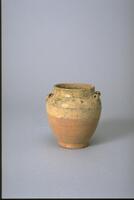
Chinese (Chinese (culture or style))
Jar
1100 – 1399
Gift of Mrs. Caroline I. Plumer for the James Marshall Plumer Collection
1973/2.29
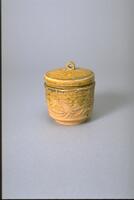
Chinese (Chinese (culture or style))
Covered Jar
1100 – 1399
Gift of Mrs. Caroline I. Plumer for the James Marshall Plumer Collection
1973/2.26
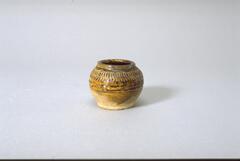
Chinese (Chinese (culture or style))
Jar
1100 – 1399
Gift of Mrs. Caroline I. Plumer for the James Marshall Plumer Collection
1973/2.28
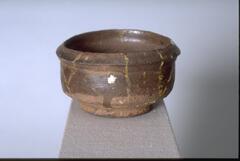
Chinese (Chinese (culture or style))
Bowl
1100 – 1399
Gift of Mrs. Caroline I. Plumer for the James Marshall Plumer Collection
1973/2.25
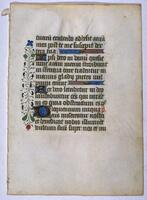
French (French (culture or style))
Leaf from a Book of Hours
1400 – 1425
Anonymous Gift in memory of Mrs. John Alexander
1993/2.9
![<p>This vessel conforms to a type of Goryeo celadon bottle that features a bulbous body, which has its center of gravisty at the lower part of the body, but its neck is rather stout when compared to the bottles produced in the 12th and 13th centuries. The shouler is decorated with a yeoui-head band, while chrysanthemum orets adorn the body in four places. The chrysanthemum designs were first stamped into the clay and inlaid with white slip; this stamping technique (inhwa) later developed into the style known as stamped buncheong ware. The base displays large cracks formed during ring. The glaze was unevenly fused, causing running and opaque melting in parts.<br />
[Korean Collection, University of Michigan Museum of Art (2014) p.145]</p>
<p>This vessel conforms to a type of Goryeo celadon bottle that features a bulbous body, which has its center of gravisty at the lower part of the body, but its neck is rather stout when compared to the bottles produced in the 12th and 13th centuries. The shouler is decorated with a yeoui-head band, while chrysanthemum orets adorn the body in four places. The chrysanthemum designs were first stamped into the clay and inlaid with white slip; this stamping technique (inhwa) later developed into the style known as stamped buncheong ware. The base displays large cracks formed during ring. The glaze was unevenly fused, causing running and opaque melting in parts.<br />
[Korean Collection, University of Michigan Museum of Art (2014) p.145]</p>](/media/W1siZiIsIjIwMjIvMDkvMjQvNWdnbWJmZmI0cF9kZWZhdWx0LmpwZyJdLFsicCIsInRodW1iIiwiMjQweDIwMCJdXQ?sha=e5ed2797dd68f3bf)
Korean (Korean (culture or style))
Buncheong ware small bottle with chrysanthemum and ruyi ('cloud collar') designs
1300 – 1499
Gift of Bruce and Inta Hasenkamp and Museum purchase made possible by Elder and Mrs. Sang-Yong Nam
2004/1.260
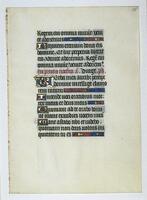
French (French (culture or style))
Leaf from a Book of Hours
1485 – 1500
Bequest of Mrs. John Alexander
1992/2.7
Loading…
